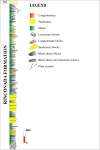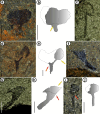The southwesternmost record of late Silurian (Pridolian) early land plants of Gondwana
- PMID: 39333147
- PMCID: PMC11436854
- DOI: 10.1038/s41598-024-63196-4
The southwesternmost record of late Silurian (Pridolian) early land plants of Gondwana
Abstract
The Silurian-Devonian transition played a crucial role in the development of early terrestrial ecosystems due to the rapid diversification of early vascular plants. However, records of Pridolian plants in western Gondwana are scarce, limited to outcrops located in southern Bolivia. In this contribution, an association of fossil plants housed in the Rinconada Formation is presented. This association corresponds to primitive fossil flora with reproductive structures and sterile axes linked to basal tracheophytes. The fossil assemblage is composed of Aberlemnia caledonica, Caia langii Cooksonia cf. cambrensis, C. paranensis, C. cf. pertoni, Hostinella sp, Cf. Isidrophyton sp, Salopella marcensis, Steganoteca striata, two morphotypes of doubtful taxonomy, and graptolites colonies. The association between flora remains and graptolites, represents a parautochthonous assemblage in an inner marine platform, dominated by gravity flows. This record has paleophytogeographic importance indicating the extension of the northwest Gondwana-southern Laurusia unit to more southern areas of Gondwana. This expansion would have been favored by the post-glacial climatic improvement of the Late Silurian, together with a great radiation capacity and environmental flexibility of the flora. Furthermore, the biochron is extended of three taxa (A. caledonica, C. paranensis and Cf. Isidrophyton sp) first known from the Lochkovian, to the Pridoli.
Keywords: Early land plants; Gondwana; Paleophytogeography; Pridoli; Rinconada formation.
© 2024. The Author(s).
Conflict of interest statement
The authors declare no competing interests.
Figures







References
-
- Wellman, C. H., Osterloff, P. L. & Mohiuddin, U. Fragments of the earliest land plants. Nature425, 282–285. 10.1038/nature01884 (2003). - PubMed
-
- Rubinstein, C. V., Gerrienne, P., de la Puente, G. S., Astini, R. A. & Steemans, P. Early middle ordovician evidence for land plants in Argentina (eastern Gondwana). New Phytologist188, 365–369. 10.1111/j.1469-8137.2010.03433.x (2010). - PubMed
-
- Salamon, M. A. et al. Putative late ordovician land plants. New Phytologist218, 1305–1309. 10.1111/nph.15091 (2018). - PubMed
-
- Xu, H., Wang, K., Huang, Z., Tang, P., Wang, Y., Liu, B., & Yan, W. The earliest vascular land plants from the Upper Ordovician of China (2022).
-
- Kenrick, P. & Crane, P. R. The origin and early evolution of plants on land. Nature389, 33–39. 10.1038/37918 (1997).
MeSH terms
LinkOut - more resources
Full Text Sources

